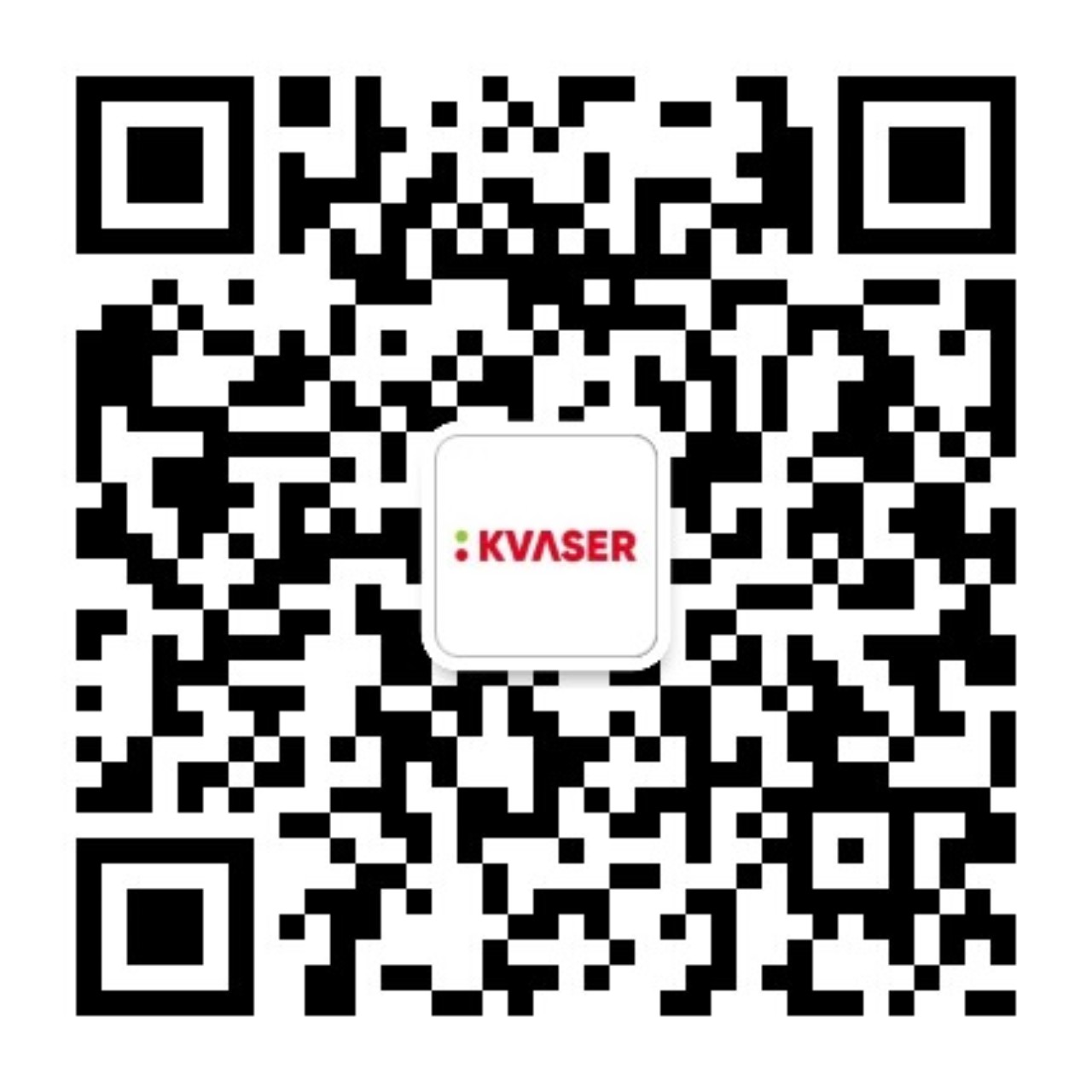在此博客中,我将展示怎样通过昵称而不是CANlib通道号,连接到特定的一路Kvaser CAN通道。此方法可实现让一路CAN通道为指定接口的专用通道。
技术博客
怎样连接到特定的Kvaser CAN通道
1. 自定义通道名称
用户常常问我们 (support@kvaser.com)的一个问题是 :
• 我是否能让我的电脑总是以相同的顺序启动我的Kvaser接口?
很遗憾,对这个问题的回答是否定的。
通常,如果你有多个接口,那么每次都会以相同的顺序启动这些接口,但是如果你修改了一个接口,那么顺序就会不同。
• 是否可以用标识符命名每个通道?
是的,可以为每路通道设置一个名称,以标识通道。
(将在稍后另一个博客中解释)
有一个非常简单的方法,不需要复杂的操作,就可以很容易打开一路特定的CAN通道。我们所有的(Kvaser)接口都有一个产品代码(EAN)和一个序列号,再加上“卡上的通道号”,这三个数据字段创建了一个独特的组合。
例子

我的“Kvaser USBcan Pro 2xHS v2”接口有两路通道, 0 和1, 它们在CANlib中显示为1和2。
2. 查找一路特定通道的通道信息

如果我们查看我的“Kvaser USBcan Pro 2xHS v2”接口, 我们会看到:
设备 EAN 73-30130-00752-9 (这是产品系列号)
系列号 12160
卡上通道 0 (在此第一路通道上)
卡上通道 1 (在此第二路通道上)
如果我基于此信息创建一个名称,例如“00752-9:12160/1”,那么此名称将始终指向我的“USBcan Pro”的第二路通道,没有其他Kvaser接口具备此组合。
因此,如果我已将“00752-9:12160/1”连接到一个高度机密的测试对象,那么我就知道当我打开该名称组合,我将始终与该测试对象通信,同时我并不需要了解我的电脑中安装了多少个其他接口。这类似于canOpenChannel(‘00752-9:12160/1’,flags)。
2.1. CANlib命令canOpenChannel()
通常,当我们调用命令canOpenChannel时,我们会提供一个CANlib通道号和一些FLAG(标志)。
我们可以改用canOpenChannel(‘00752-9:12160:1’,flags)句式吗?
实际上,在最理想的情况下,这个命令应该已经是CANlib的一部分了,但是它还尚不存在,所以你必须自己去做。
2.2. 用户自定义的MycanOpenChannel()
让我们创建一个命令: MyCanOpenSpecificChannel()
Delphi
function MyCanOpenSpecificChannel(const NickName: string; const flags: integer; var FoundChannel: integer): canHandle;
Parameters(参数)
[in] NickName String with “EAN:SN/ChOnCard” (‘00752-9:12160/1’)
(带有“EAN:SN/ChOnCard”的昵称字符串)
[in] flags A combination of canOPEN_xxx flags (一个canOPEN_xxx的组合)
[out] FoundChannel(找到的通道) The number of the opened channel(已打开的通道数)
Returns(返回)
返回一个给断开回路的句柄,或者,如果调用失败,则返回canERR_xxx (负)。
完整的MyCanOpenSpecificChannel() 函数目录请见附录A。
我们假设昵称包含‘00752-9:12160/1’。让我们调用函数SplitNickNameStringPlease(), 它将返回EAN、SN和NoOnCard。
EAN = ‘00752-9’
SN = 12160
NoOnCard = 1
通过canGetChannelData()命令,我们可以获取所连接相关接口的大量信息。我们将使用参数:canCHANNELDATA_CARD_SERIAL_NO, canCHANNELDATA_CHAN_NO_ON_CARD 和 canCHANNELDATA_CARD_UPC_NO。
canCHANNELDATA_CARD_SERIAL_NO uses a 64bit integer
canCHANNELDATA_CHAN_NO_ON_CARD uses a 32bit integer
canCHANNELDATA_CARD_UPC_NO uses a 64bit BCD string
所以通过调用 (当迭代通过所有通道时 (I)):
canGetChannelData(I, canCHANNELDATA_CARD_SERIAL_NO , U64_1, sizeof(U64_1));
canGetChannelData(I, canCHANNELDATA_CHAN_NO_ON_CARD, U32_1, sizeof(U32_1));
canGetChannelData(I, canCHANNELDATA_CARD_UPC_NO , U64_2, sizeof(U64_2));
我们将在U64_1,U32_1 和 U64_2中收到一些信息。
U64_1 and U32_1将包含卡上相应通道号的系列号,并且我们可以很容易地将它与我们的搜索值进行比较。
U64_2包含EAN编号,我们需要做一些处理才能读取EAN编号。
首先,将U64_2转换为16位长的十六进制字符串,
2026405030294825 ToHexString变为: ‘0007330130007529’
完整的EAN代码是73-30130-00752-9,所以很容易找到我们要复制的内容
73-30130-00752-9 ‘0007330130007529
st := copy(st, 11, 5) + ‘-‘ + copy(st, 16, 1);
我们在寻找状况:
EAN = ‘00752-9’
SN = 12160
NoOnCard = 1
如果 (U64_1=SN) 和 (U32_1=SN) 以及 (EAN=st),那么我们已经找到了我们的接口, 让我们返回此通道号并尝试调用 canOpenChannel()。
你可以在附录A中看到函数的完整列表。
3. 结论
当然,你几乎可以选择任何格式来描述某个特定通道。
我在此博客中要解释的是,通过三次调用canGetChannelData(),你将收到足够的信息来确定,是否它就是你要打开的某个通道。
我希望本文会对你有帮助。欢迎评论和提问!
4. 附录A :MycanOpenChannel()
4.1. 函数MycanOpenChannel()
function MycanOpenChannel(const NickName: string; const flags: integer; var FoundChannel: integer): canHandle;
var
I: integer;
EAN : string;
SN : UINT64;
ChNoOnCard: UINT32;
N: integer;
UI64 : UINT64;
UI32 : UINT32;
st : string;
begin
result := canERR_NOTFOUND;
FoundChannel := canERR_NOTFOUND;
/// Most probably, NickName contains something like:'00752-9:12160:0'
/// EAN=00752-9 (this is the last part of Device EAN 73-30130-00752-9)
/// sn = 12160
/// NoOnCard=0
if SplitNickNameStringPlease(NickName, EAN, SN, ChNoOnCard) then
begin
// Let us see if we can find the combination of EAN, SN, ChNoOnCard
if (canGetNumberOfChannels(N) = canOK) then
begin
for I := 0 to N - 1 do
begin
// Look for SN first
if (canGetChannelData(I, canCHANNELDATA_CARD_SERIAL_NO, UI64, sizeof(UI64)) = canOK) then
begin
if (UI64 = SN) then
begin
if (canGetChannelData(I, canCHANNELDATA_CHAN_NO_ON_CARD, UI32, sizeof(UI32)) = canOK) then
begin
if (UI32 = ChNoOnCard) then
begin
// We have found a channel with SN and NoC that is correct, let see if EAN is correct
if (canGetChannelData(I, canCHANNELDATA_CARD_UPC_NO, UI64, sizeof(UI64)) = canOK) then
begin
st := UI64.ToHexString(16);
st := copy(st, 11, 5) + '-' + copy(st, 16, 1);
if (st = EAN) then
begin
FoundChannel := I;
break; // Breaks the FOR-loop
end;
end;
end;
end;
end;
end;
end;
if FoundChannel >= 0 then
begin
// Let us use "FoundChannel" and see what happens
result := canOpenChannel(FoundChannel, flags);
end;
end;
end;
End;
4.2. 函数 SplitNickNameStringPlease()
function SplitNickNameStringPlease(const NickName: string; var EAN: string; var SN: UINT64; var NoC: UINT32): boolean;
var
P : integer;
st : string;
temp: string;
begin
result := false;
try
// '00752-9:12160/0'
temp := NickName;
P := pos(':', temp);
if P > 0 then
begin
EAN := copy(temp, 1, P - 1);
temp := copy(temp, P + 1, 1024);
EAN := trim(EAN); // remove leading and trailing spaces
while length(EAN) < 7 do
begin
EAN := '0' + EAN; // add leading zeros if needed
end;
P := pos('/', temp);
if P > 0 then
Begin
st := copy(temp, 1, P - 1);
SN := st.ToInteger;
st := copy(temp, P + 1, 1024);
NoC := st.ToInteger;
result := true;
end;
end;
except
result := false;
end;
end;

